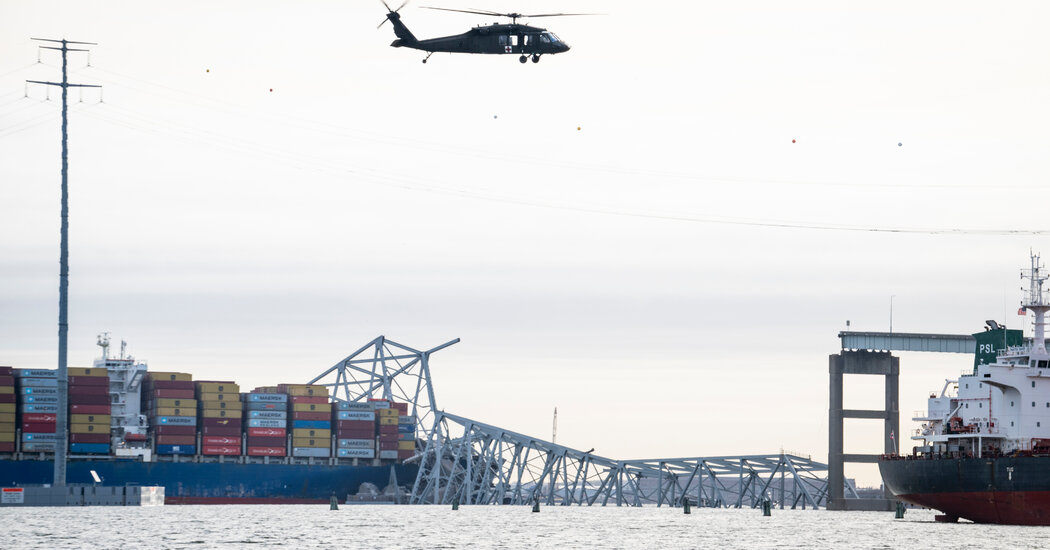Follow our live coverage of the Francis Scott Key Bridge collapse in Baltimore.
A giant container ship struck the Francis Scott Key Bridge in Baltimore at about 1:30 a.m. on Tuesday. Most of the bridge collapsed into the Patapsco River.
Gov. Wes Moore of Maryland declared a state of emergency shortly after the ship hit the bridge, a part of Interstate 695 and a critical transportation link on the Eastern Seaboard to one of the largest ports in the country. Vessel traffic has since been stopped.
Officials suspended the search and rescue effort on Tuesday night and the six missing construction workers are presumed dead.
Governor Moore said that there was no credible evidence of a terrorist attack. The priority, he said, was a search operation, led by the Coast Guard, to try to find people who may have been on the bridge.
Here’s what we know.
Why did the ship hit the bridge?
It is not known, and the National Transportation Safety Board said it is investigating.
The 985-foot-long cargo vessel, called The Dali, was leaving the Port of Baltimore when it lost power and issued a mayday call just before hitting a critical component of the bridge, known as a pylon or pier. Radio traffic from emergency workers suggested that the crew was struggling to steer the ship, according to audio published by Broadcastify. Most of the lights of the ship went dark abruptly, just over two minutes before the ship hit the bridge.
Baltimore harbor pilots were directing the ship at the time of the crash, as is customary when vessels enter ports or canals, according to a joint statement from the ship’s owner and manager.
Governor Moore said the bridge was fully up to code, and that the collapse did not appear to be the result of a structural issue.
What is the death toll?
Coast Guard and state police officials said the construction workers had been missing too long to hope for rescue and cited cold water temperatures. Col. Roland L. Butler of the Maryland State Police said divers would attempt to return to the water to try to recover the bodies.
Two other workers were rescued from the water, including one who was hospitalized and released.
At least one of the missing men was an immigrant from El Salvador, according to We are Casa, a nonprofit that provides services to the immigrant community in Baltimore.
Miguel Luna, 40, is married and has three children, said Gustavo Torres, the organization’s executive director. He learned that Mr. Luna was one of the missing from Mr. Luna’s family. He said Mr. Luna had been living in Maryland for at least 19 years.
What about the ship and crew?
The Dali is registered in Singapore, and was headed for Colombo, Sri Lanka, according to MarineTraffic, a maritime data platform. It was carrying 4,700 shipping containers, according to Synergy Marine, its manager and operator. But the ship’s capacity can handle about twice as many, according to the company.
An inspection of the ship last year at a port in Chile reported that the vessel had a deficiency related to gauges and thermometers.
The Dali has had 27 inspections since 2015, according to a database maintained by Equasis, a public site that promotes maritime safety. The only other deficiency, a damaged hull “impairing seaworthiness,” was found in 2016 at the port of Antwerp. The vessel hit a stone wall at the port that year. A spokesman for the Dali’s owner, Grace Ocean Investment, declined to comment on the deficiency turned up last year.
Despite the mayday call, the road repair crew and its vehicles remained on the bridge, the authorities said. It is not clear why they did so.
At the same time, the ships’s 24 crew members, including two Baltimore port pilots who were directing the vessel at the time of the crash, were accounted for, and there were no injuries among those on the ship, the owners said. On board were 22 Indian citizens.
What about the bridge?
Construction of the bridge started in 1972 and was completed in March 1977. The bridge spans 1.6 miles over the Patapsco River, but the crossing’s overall structure, including its connecting approaches, is almost 11 miles long.
More than 12.4 million passenger and commercial vehicles crossed the bridge in 2023, according to a Maryland state government report.
The collapse might have been avoided, some engineers said, if the pylons holding up the bridge were better protected with blocking devices called fenders. Those can be anything from simple pyramids of rocks piled around the pylons, to major concrete rings padded with slats of wood. But the protection would have had to be able to absorb a hit from such a huge container vessel.
President Biden said he expects that the federal government will pay for the “entire cost” of rebuilding the bridge, and called on Congress to support efforts to fund the repairs.
Reporting was contributed by Peter Eavis, Miriam Jordan, Nicholas Bogel-Burroughs, Jacey Fortin, James Glanz, Annie Correal, Michael D. Shear, Luke Broadwater, Jenny Gross, Patricia Mazzei and Jin Yu Young.


